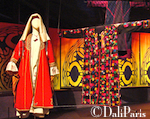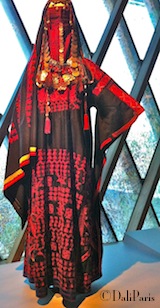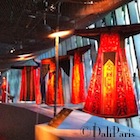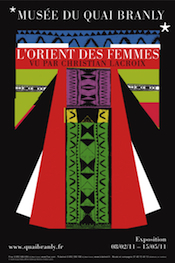Christian Lacroix Tribute to Muslim women at Branly Museum

- SUBSCRIBE
- ALREADY SUBSCRIBED?
BECOME A BONJOUR PARIS MEMBER
Gain full access to our collection of over 5,000 articles and bring the City of Light into your life. Just 60 USD per year.
Find out why you should become a member here.
Sign in
Fill in your credentials below.
 Currently at Musée du Quai Branly, French fashion designer Christian Lacroix and Branly curator Hana Chidiac present “L’Orient des femmes vu par Christian Lacroix,” a stunning exhibition of 175 of the most precious traditional gowns and accessories worn by women from the Fertile Crescent area of Western Asia. A map in the complimentary printed exhibition guide available at the entry defines this region as Egypt, Iraq, Israel, Jordan, Libya, Syria and Turkey. Western textbooks refer to this area as the “cradle of civilization.”
Currently at Musée du Quai Branly, French fashion designer Christian Lacroix and Branly curator Hana Chidiac present “L’Orient des femmes vu par Christian Lacroix,” a stunning exhibition of 175 of the most precious traditional gowns and accessories worn by women from the Fertile Crescent area of Western Asia. A map in the complimentary printed exhibition guide available at the entry defines this region as Egypt, Iraq, Israel, Jordan, Libya, Syria and Turkey. Western textbooks refer to this area as the “cradle of civilization.”
Three years in the making, the vibrant costumes expose how Arab and Bedouin women dressed before Islamic rule in the 1970s required they be covered in burqas. Instead of simple peasant robes, vibrantly decorated folk wear was intentionally chosen to represent a form of female expression silenced last century.
Most of the priceless articles have never before been shown in France. The exhibition consists of pieces from the Branly’s permanent collection and the private collection of Widad Kawar of Jordan. Madame Kawar is an international expert who has devoted nearly five decades to preserving and promoting understanding of Arab culture.
The exhibition guide quotes Lacroix as saying his heart dictated his choices of items that inspired him. Lacroix is a legendary Paris designer who created some of the world’s most extravagant couture and ready-to-wear of the late 20th century.
Chidiac, who curates the Branly’s North African and Near East collections, considers herself a “guide” who advised Lacroix on historically significant details related to his selections from the Branly and Kawar collections.
 Some gowns are grouped on floating crosses as solo mannequins draped in more ornate gowns, veil and slippers draw deserved attention. Look closely at the intensity of the fabric colors and degree of gown ornamentation, particularly embroidery and appliqued mirrors, coins and beads. Every village had its own distinct embroidery patterns and gowns were carefully chosen and passed down from mothers to daughters. The assembled collection offers a glimpse at how Arab females communicated through expressive costumes that revealed their social status, religion and region of residence.
Some gowns are grouped on floating crosses as solo mannequins draped in more ornate gowns, veil and slippers draw deserved attention. Look closely at the intensity of the fabric colors and degree of gown ornamentation, particularly embroidery and appliqued mirrors, coins and beads. Every village had its own distinct embroidery patterns and gowns were carefully chosen and passed down from mothers to daughters. The assembled collection offers a glimpse at how Arab females communicated through expressive costumes that revealed their social status, religion and region of residence.
A separate side room contains hand-embroidered fabric squares cut from three Jordanian gowns. A large poster above reads, “Please touch!” with instructions on the proper way to caress and examine the fabric and embroidery, something that can’t be done with exhibited items too fragile to tolerate such manipulation. Folk dolls and framed gouache paintings of gowns may also be found in this room.
Lacroix was very involved in staging the exhibits, from arranging displays to creating the promotional exhibition poster that features Lacroix’s original abstract art inspired by a Jordanian gown. Chidiac credits Lacroix with wrapping the modern museum’s mezzanine with puffy taffeta clouds that hover above rugs she called “flying carpets.”

It takes about an hour for a superficial glance at all displays arranged by region and color, from dark to light. One could spend twice that time thoughtfully reading descriptive text and watching classic videos included in the exhibition. Do not miss the Egyptian black and white bellydancing film clips and a grainy video of a village woman demonstrating how yards of fabric, sash and ornamental headpiece are layered to cover all but the woman’s smiling face.
Pairing flamboyant Lacroix with anthropological expert Chidiac was brilliant and together they present a culturally relevant and historically accurate program.
The exhibition succeeds in its goal of paying homage to Middle Eastern women more typically represented in the West as silenced victims. To the contrary, Lacroix’s exhibit proves female artisans of the Fertile Crescent were muses to men who built ancient empires and even a modern French fashion empire.
This exhibition closes May 15, 2011.
37, quai Branly, Paris 7th
Tél. : 01 5661 7000
Métro: #6 Bir-Hakeim (Tour Effiel), 8 La Tour-Maubourg, #9 Iéna
RER: C Pont de l’Alma
Bus: 42, 92, 80, 63, 82, 72, 73, 87, 69, 82
Velib: 7023 Quai Branly
Exhibition ticket: 8.50€, 6€ reduced; free 1st Sunday of the month
2011 hours: Tue, Wed, Sun: 11am-7pm Thu, Fri, Sat: 11am-9pm
About the writer:
Dali Wiederhoft has adored Paris ever since her grandmother showed her a cherished 1950s colored pencil sketch of Opera Garnier. When not indulging in Paris café life, she is likely daydreaming about it. Today that souvenir and many others are displayed in Dali’s cottage full of such sentimental French treasures.
Please visit our Amazon affiliate store for your shopping. Bonjour Paris has hand-selected some of our favorite travel gifts, electronics, gourmet items and gadgets for our readers… plus many Paris- and France-related books for children, travelers, scholars, and dreamers.
City Segway Tours are great for seeing Paris in a different light. You’ll see more, have more fun, and not feel tired at the end of it. These are highly recommended and truly a great thing to do during your stay.
More in Bonjour Paris, Branly, Christian Lacroix, cultural differences, Dali Wiederhoft, Exhibitions, Museum, Muslim culture, Paris fashion, Paris museums


